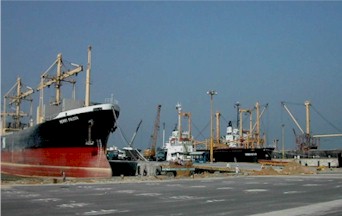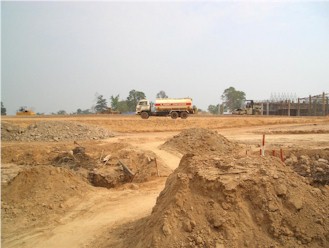Port
|
Port: Poor
- Ports and terminals :Banjarmasin,
Belawan, Ciwandan, Krueg
Geukueh, Palembang, Panjang, Sungai Pakning, Tanjung Perak, Tanjung
Priok
- The majoy ports handling most of
Indonesia's export and import cargoes are tanjung Priok, Surabaya,
Semarang, Belawan, and Makassar.
- Operation of Tajung Priok is less
efficient compared to to other major ASEAN Ports, with small hanling
capacity for vehicle cargo.
- Terminal handling charges in the country
are the highest among major ASEAN ports.
Merchant marine:
Total: 824 ships (1000 GRT or over)
3,773,771 GRT/4,887,614 DWT
by type:
bulk carrier 43, cargo 451, chemical tanker 21, container 50, liquefied
gas 7, livestock carrier 1, passenger 41, passenger/cargo 58, petroleum
tanker 132, refrigerated cargo 2, roll on/roll off 12, specialized
tanker 4, vehicle carrier 2
Foreign-owned:
30 (France 1, Germany 1, Japan 3, South Korea 1, Norway 1, Philippines
1, Singapore 17, Switzerland 3, UK 2)
Registered
in other countries: 122 (Bahamas 4, Belize 2, Bermuda 1, Cambodia 1,
Georgia 1, Hong Kong 4, Liberia 1, Panama 50, Singapore 56, Thailand 1,
unknown 1) (2006)
|
|
Airport
|
Airport: Fair
- Major
international airports are Jakarta, Surabaya, Medan,
Semarang, Denpasar, Manado and Palembang.
- Because of the insufficient sea and land
transport
networks, air freight transport is becoming increasing
in demand of use. Also, because of it's relatively
lower fares.
More on Airports in Indonesia: http://www.business-in-asia.com/airports_indo.html
Airports: 662 (2006)
Airports - with
paved runways:
Total: 159
over 3,047 m: 4
2,438 to 3,047 m:
15
1,524 to 2,437 m:
49
914 to 1,523 m: 49
under 914 m: 42
(2006)
Airports - with
unpaved runways:
Total: 503
1,524 to 2,437 m:
6
914 to 1,523 m: 26
under 914 m: 471
(2006)
|
|
Road
|
Road: Fair
- Roads
play most important roles in cargo
transportation - approximately 96% of total
cargo
- Althought the roads have been developed
especially for access
to may economic centers, traffice congestion in the cities has been a
problem. Especially, heavy traffic congestion in central Jakarta
and Surabaya
is quite serious
- Poor accessibility to Tanjung Priok
Ports
causes stagnated freight transport
Total: 368,360 km
paved: 213,649 km
unpaved: 154,711
km
|
|
Railway
|
Railway: Good
- Indonesia
has four unconnected railway
systems: one in Java, and three
in Sumatra.
- The availability and reliability of
service are low, due to inadequate maintenance and lack of spare parts
- Freight traffic moved by the Java
railways consists mostly
of petroleum fuel, fertilizer, cement and coal
Total: 6,458 km
narrow gauge:
5,961 km 1.067-m gauge (125 km electrified); 497 km 0.750-m gauge (2005)
|
|
|



